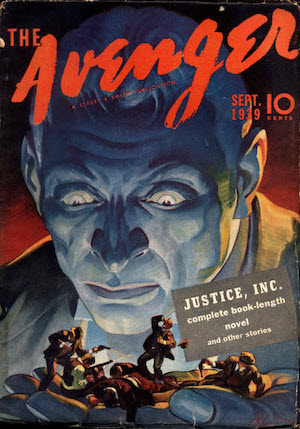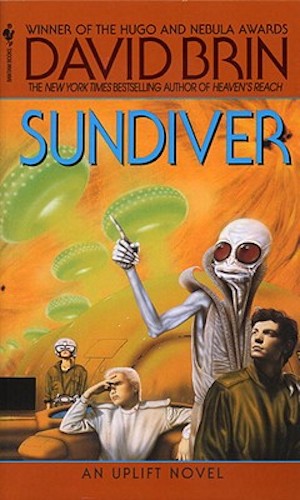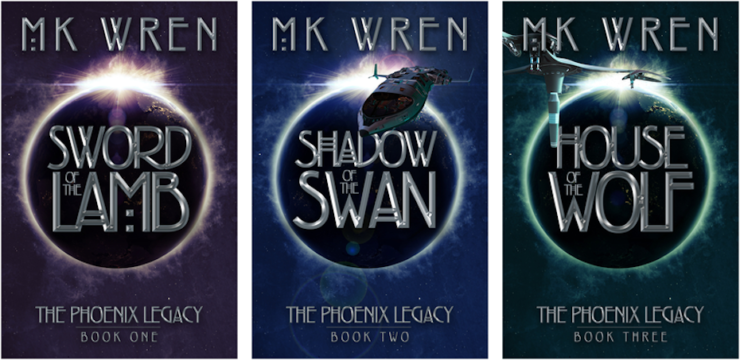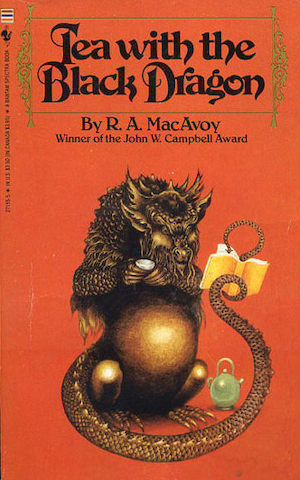Recently I reviewed a venerable book I won’t identify beyond saying that it was Margaret Weis and Tracy Hickman’s Dragons of Autumn Twilight. There are many levels on which this unnamed book could legitimately be criticized, none of which mattered to the legions of readers who bought it and its many, many, many sequels. The moral here is that readers will overlook a multitude of flaws provided the book in hand manages to scratch the right itch at the right time.
At present I am immune to the charms of the unidentified book. However there are other books I read in my youth that, while flawed, are still pleasant reads. In spite of the fact that they’re a bit dated and/or lack some conventional virtues like delectable prose, compelling plotting, and vivid characterization, they still manage to hold my attention. Here’s a sample of five books that I continue to revisit from time to time despite their flaws or shortcomings.
Justice, Inc. by Kenneth Robeson (1939)

Accompanied by wife Alicia and daughter Alice, millionaire adventurer Richard Benson bullies his way onto a passenger plane. Fastidious Benson washes his hands in mid-flight. When he returns to his seat, Alicia and Alice are nowhere to be seen. In fact, the crew and other passengers insist Benson boarded alone. When Benson protests, he is overpowered and knocked out cold. He wakes weeks later, physically transformed by the trauma. Benson sets out to discover the fate of his wife and child, armed only with nigh-superhuman strength and reflexes, a vast fortune, and the new, trauma-induced ability to shape his paralyzed face into any face he wishes. Oh, and also many years of experience as an adventurer. Will such paltry assets suffice?
Justice, Inc shows its roots in the pulp era. It’s short. The plot moves forward energetically, without much care as to whether or not it makes sense. The prose is functional at best. The author is fond of convenient tropes like Women in Refrigerators. Alas for poor Alicia and little Alice.
Kenneth Robeson is a pen name used by Paul Ernst for the Avenger pulp novels. Another writer, Lester Dent, who wrote the Doc Savage novels, also used the same pen name, which was owned by the publisher of both series, Street & Smith.
What makes Justice, Inc and the series of which it was a part stand out for me was that that the Avengers books were books about teamwork, whereas the Doc Savage books were all Doc, all the time. Sure, Benson has resources and is highly capable. That’s insufficient. The key to success is Benson’s ability to recognize and recruit people whose skills and resources complement his.
In this particular adventure, Benson joins forces with fellow victims of injustice Fergus “Mac” MacMurdie and Algernon Heathcote “Smitty” Smith. Mac is a skilled chemist; Smitty is a skilled mechanic and full-time bruiser. This sets the pattern for the series; the early books expand Benson’s team with other skilled, resourceful people. Benson depends on his team, whereas Doc Savage had hangers-on who supplied him with lavish praise and were occasionally held hostage, giving Doc a reason for a daring rescue.
Sundiver by David Brin (1980)

Much to humanity’s collective alarm, humans are not the first civilization to reach the stars. Worse yet, the billion-year-old culture (containing many non-human species) that beat us to the punch is vastly more technologically sophisticated than we are. Worst of all, the culture is rigidly hierarchical; humans must somehow fit into this society or suffer dire consequences. Having already violated some core tenets with our treatment of the Earth’s environment, humans must tread carefully lest one alien faction or another decide to exterminate the affront that is wolfling humanity. As fate has it, Sundiver—humanity’s effort to send a crewed spacecraft into the sun itself—will play a role in the delicate dance between alien and human.
Modern readers will likely find Sundiver (the novel, not the spacecraft in the novel) a bit too much of its era; not in a good way. The treatment of women in this novel makes it obvious that the novel was published closer to the midpoint of the 20th century than to today. The “uplift” which gives Brin’s series its name involves a combination of genetic manipulation and selective breeding, though the humans in the novel decry the way senior galactic patrons treat their servant races. As to the science: Brin, even at the time, must have known that cooling lasers could not work as he has them work in the book. Too bad that many readers must have accepted this as science fact.
However! The novel in hand is not the grand-scale space opera one might expect. It’s a murder mystery on an isolated space craft. It just so happens that I am, in addition to being an SF fan, am also a fan of murder mysteries set in isolated locations. Sundiver was an engaging example of the form—it is hard to get more isolated than a location within the Sun.
The novel’s structure also provided what I assume was an entirely unintended source of entertainment. Brin established the lead’s backstory convincingly enough that many readers believed that Sundiver the novel was just the latest in an ongoing series (rather than the first). We did not have ISFDB to consult back in those days. Thus, for years regulars on Usenet’s rec.arts.sf.written fielded questions about Sundiver’s non-existent predecessors. Being kindhearted people, we’d console them with the knowledge that they could at least now redirect their efforts into searching for John D. MacDonald’s classic Black Border for McGee…
The Illuminatus! Trilogy by Robert Shea and Robert Anton Wilson
The Eye in the Pyramid (1975), The Golden Apple (1975), Leviathan (1975)

Across America and the world, people find themselves facing seemingly unrelated challenges. New York Detectives Saul Goodman and Barney Muldoon have a bombing to solve. Reporter George Dorn is arrested in Mad Dog, Texas. The UK’s Agent 00005, Fission Chips, is dispatched to tiny Fernando Po to investigate Russian (or possibly Chinese) skullduggery. An American president is determined to appear resolute and strong; the nonexistent Russian (or possibly Chinese) activity in Fernando Po is just the thing to justify the use of America’s new super-weapon. In fact, all of these events are connected—evidence of a vast, planet-spanning conspiracy dating back centuries.
Inspired by various deranged letters Shea and Wilson read while working for Playboy Magazine, The Illuminatus! Trilogy is so very 1970s. If the authors were not actually on drugs when they wrote their epic celebration of paranoia, they gave a great impression that they were. The trilogy is energetically, gleefully incoherent as it tries to present a world in which all conspiracies are true.
The Phoenix Legacy by M. K. Wren
Sword of the Lamb (1981), Shadow of the Swan (1981), House of the Wolf (1981)

The Concord that rules our Solar System and the Alpha Centauri system a thousand years from now is technologically sophisticated. It also features a brutal caste system. Legions of uneducated, oppressed Bond folk serve a very small number of Elite. There’s a comparative handful of educated Fesh (professionals) who work for the Elite and help hold this creaky society together. Bonds occasionally rebel against oppression and are put down by force. Leonard Mankeen, an Elite, tried to reform the system; bloody revolt and bloodier suppression ensued. A billion people died. This disaster convinced the remaining Elite that reform—any reform—must be squelched with extreme prejudice.
But there’s hope! Brilliant but doomed Rich DeKoven Woolf and his less brilliant but far hunkier brother Alex will save the day, somehow finding a path between the Scylla of a new Dark Age and the Charybdis of handing power to a fellow revolutionary who is in fact worse than the current rulers.
Along the way, Alex will have to find some way to woo the beautiful Adrien Camine Eliseer despite the notable handicap of having faked his own death.
Younger readers will be spared the original cover art, but they will not be spared the author’s fondness for lengthy infodumps. They may also notice that while everyone is concerned about the plight of the Bonds, absolutely nobody ever suggests asking the Bonds what they think should be done. The revolution is carried out entirely by Elite and Fesh.
So, what’s to like? When I first read this, it helped that I was oblivious to the problem inherent in wanting to keep the Bonds happy enough not to rebel without being willing to give them any say in the resulting political system. I, uh, enjoy infodumps so that wasn’t an issue for me. I thought the two-star-system set-up was interestingly constrained. I enjoyed the fantasy that corrupt systems could be reformed. And, as my one of my editors (also a fan of the trilogy) reminds me, the three-book plot never flags; there are cliffhangers and suspense galore. Oh, and swordfights.
I also note that all three books in the trilogy came out in 1981. The cliffhangers would have otherwise been unbearable.
Tea with the Black Dragon by R.A. MacAvoy (1983)

Martha McNamara, former orchestral violinist turned Zen master and Celtic fiddler, arrives in San Francisco looking for her missing daughter Liz. Martha’s concern is exacerbated by the final communication Liz sent, which hinted at some crisis with which she needed help. Providentially, Martha books a room in the same hotel as the enigmatic Mayland Long. Long, believing Martha is the Zen master for whom he has been searching, assists Martha in her search for Liz. Mayland is far more than he seems—he is in fact a dragon in disguise—which is good for Martha and Liz because the people Liz is mixed up with are very bad people and Martha needs all the help she can get.
Modern readers will notice that while the plot does not quite embody the Mighty Whitey trope, in which White heroes easily master that which requires a lifetime of effort by POC, it’s close enough to touch that dubious trope with an outstretched finger. So while potential readers should be aware of that issue and the fact that the book’s portrayals will feel a bit dated, the novel also has some notable strengths. Martha is an older woman, which makes her a rarity among F&SF protagonists. The exact nature of the crime in which Liz is entangled will appeal to fans of comp.risks. The story is charming and told in sprightly fashion. Most importantly for me at the time, the paperback fit nicely in my security-guard uniform’s inside pocket without a telltale bulge and helped me stay awake through long night shifts.
***
No doubt each of you have some flawed but beloved favorites (or at least, well-liked oddities) on your shelves—and it goes without saying that your mileage may vary when it comes to the examples above. Encounters with the Suck Fairy tend to be different for everyone, and depend on a variety of factors (as does one’s level of affection for individual works encountered years and years ago). Comments are, as ever, below.
In the words of Wikipedia editor TexasAndroid, prolific book reviewer and perennial Darwin Award nominee James Davis Nicoll is of “questionable notability.” His work has appeared in Publishers Weekly and Romantic Times as well as on his own websites, James Nicoll Reviews and the Aurora finalist Young People Read Old SFF (where he is assisted by editor Karen Lofstrom and web person Adrienne L. Travis). He is a four-time finalist for the Best Fan Writer Hugo Award, is eligible to be nominated again this year, and is surprisingly flammable.










